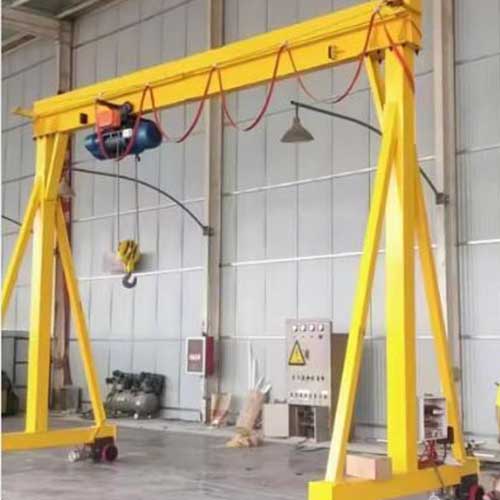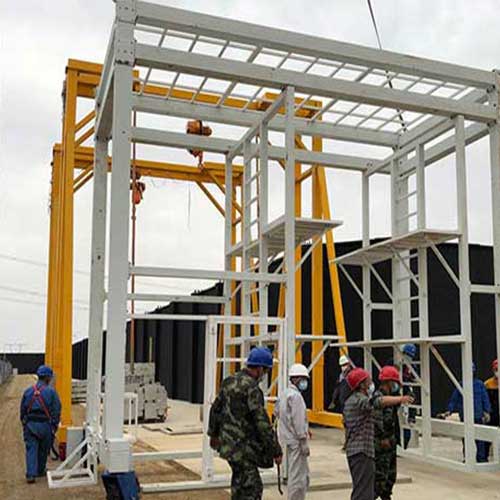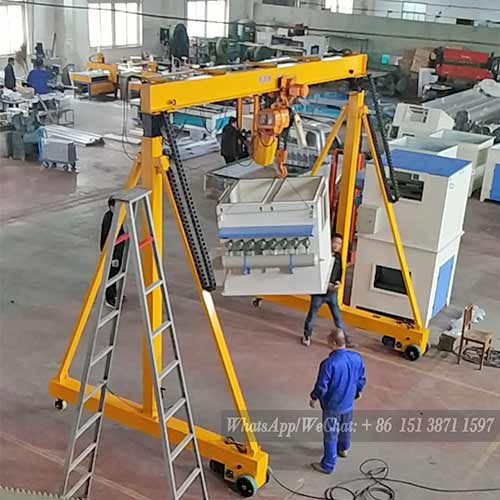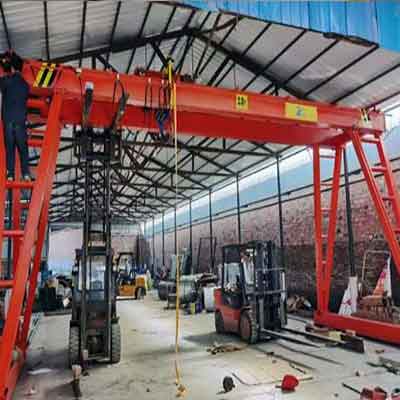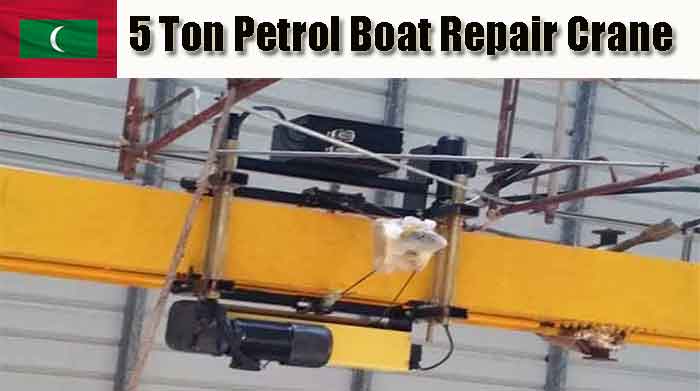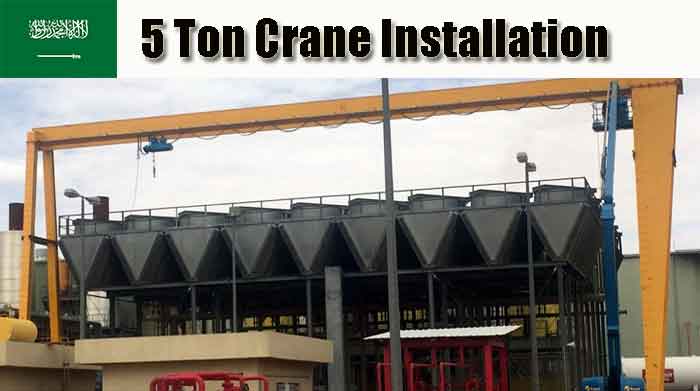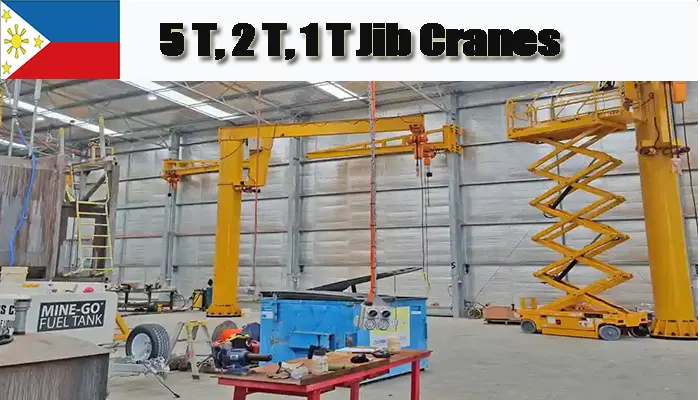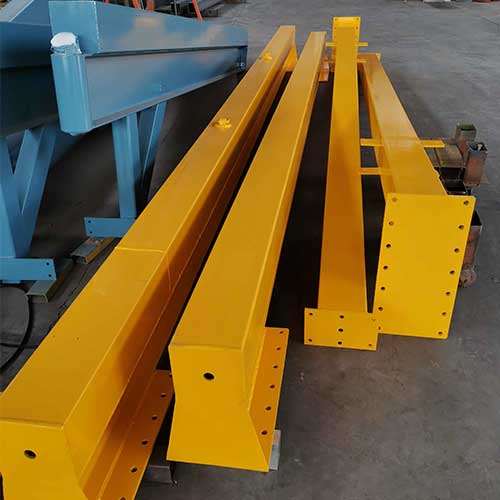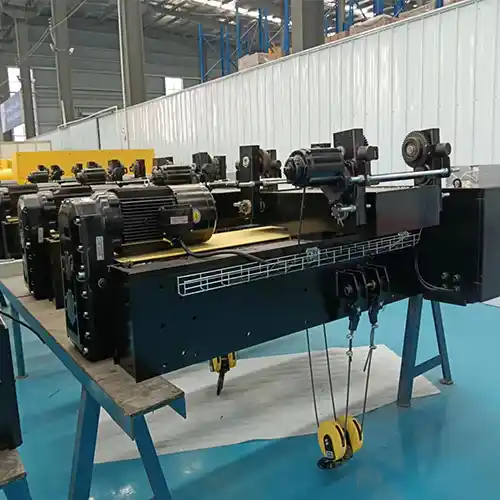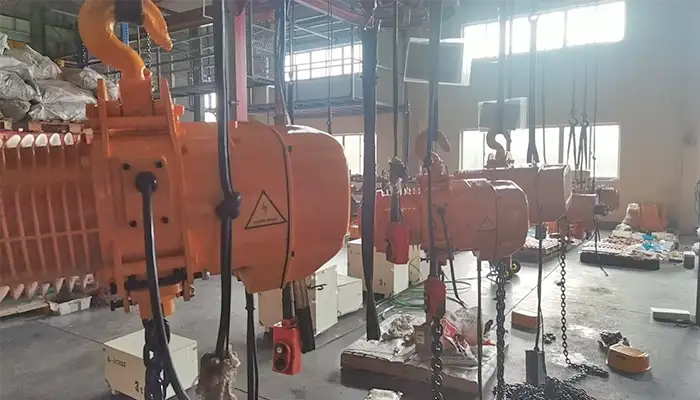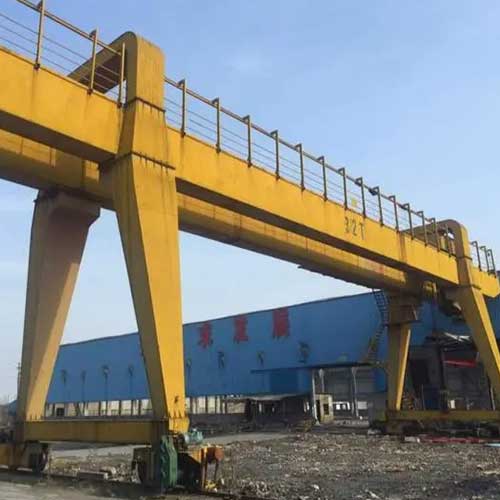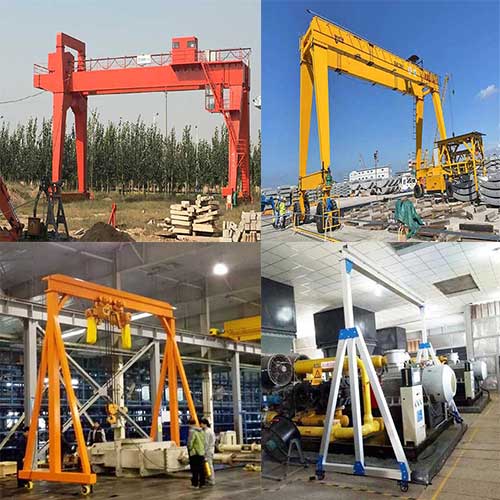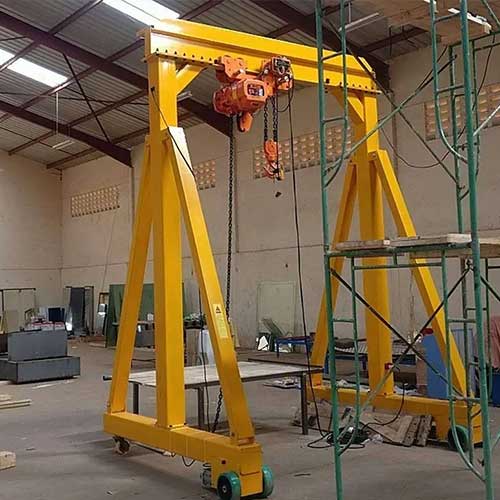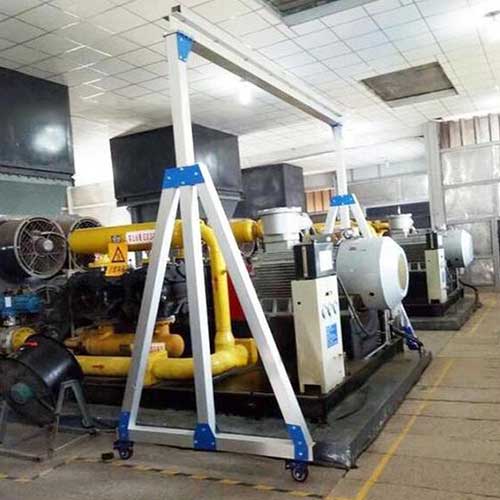5 Ton A Frame Crane, Affordable Small 5 Ton A Frame Gantry Design
5 ton a frame crane for sale, cost-effective small a frame gantry crane. Check benefits of portable A Frame Gantry Crane over other 5 ton cranes. Click now
Category: A Frame Crane
Your Trusted A Frame Crane Manufacturer & Supplier
5 Ton A Frame Crane, Affordable Small 5 Ton A Frame Gantry Design
5 ton a frame crane for sale, cost-effective small a frame gantry crane. Check benefits of portable A Frame Gantry Crane over other types of 5 ton cranes.
In industrial material handling operations, the 5 Ton A Frame Crane is a frequently adopted choice, combining strength and precision in material handling. Characterized by its distinctive A-frame design, this types of gantry crane is engineered to lift and move loads up to 5 tons with unparalleled efficiency.
The backbone of many manufacturing, construction, and logistics industries, the 5 Ton A Frame Crane plays a pivotal role in enhancing operational efficiency. Its robust design and versatile functionality make it an indispensable tool for lifting and transporting heavy loads with precision, ultimately contributing to increased productivity and safety within industrial settings.
5 Ton A Frame Cranes
Components and Structure
- A Frame Design : At the core of the 5 Ton A Frame Crane lies its distinctive A-frame structure, providing exceptional stability and load-bearing capabilities. The design ensures a balanced distribution of weight, allowing for smooth and controlled lifting operations. This structural integrity is a cornerstone for the crane's reliability in various industrial applications.
- Hoist and Trolley Systems : The hoist and trolley systems are the workhorses of the A Frame Crane, responsible for lifting and transporting loads. These systems are meticulously engineered for strength and precision, offering controlled movement across the crane's span. Advanced hoist technologies contribute to efficient vertical displacement, while trolleys enable lateral movement, enhancing the crane's versatility.
- Control Mechanisms : Modern 5 Ton A Frame Cranes are equipped with sophisticated control systems, allowing operators to manage lifting operations with precision. Remote controls and user-friendly interfaces provide ease of use, enhancing overall efficiency and safety. The integration of automation and smart control technologies further positions these cranes at the forefront of industrial innovation.
Technical Specifications
- Load Capacity : The 5-ton load capacity of these cranes makes them suitable for a wide range of industrial tasks. Whether lifting heavy machinery components or transporting raw materials, the crane's capacity ensures optimal performance in diverse applications.
- Span and Height : Tailored to suit varying workspace configurations, A Frame Cranes offer customizable spans and heights. This adaptability allows for efficient utilization of available space, making them suitable for both expansive manufacturing plants and compact warehouse environments.
- Lifting Speed and Precision : The lifting speed and precision of A Frame Cranes are crucial factors in achieving operational efficiency. These cranes are engineered for quick and controlled movements, ensuring timely and accurate handling of loads. Precision is particularly vital in industries where delicate or sensitive materials are involved.
- Power Requirements : Efficient power utilization is integral to the operational effectiveness of 5 Ton A Frame Cranes. Understanding the power requirements, including voltage and frequency considerations, ensures seamless integration into existing industrial infrastructures.
Safety Features
- Overload Protection : To safeguard both equipment and personnel, A Frame Cranes are equipped with overload protection mechanisms. These features automatically detect excessive loads and trigger protective measures to prevent potential damage or accidents.
- Emergency Stop : In emergency situations, the ability to halt crane operations swiftly is paramount. A Frame Cranes are equipped with emergency stop functionalities, allowing operators to cease all movements immediately, mitigating potential risks.
- Limit Switches : Limit switches serve as critical safety components, preventing the crane from exceeding specified travel limits. These switches contribute to the overall safety and longevity of the equipment by avoiding overextension or overretraction.
- Inspection and Maintenance Requirements : Regular inspections and maintenance routines are imperative to ensure the ongoing reliability of 5 Ton A Frame Cranes. Comprehensive checks on structural integrity, electrical systems, and safety features should be conducted, with adherence to recommended maintenance schedules. This proactive approach enhances the crane's lifespan and minimizes downtime.
Applications of 5 Ton A Frame Cranes
General Industrial Usage
5 Ton A Frame Cranes find widespread application in general industrial settings, where the need for robust material handling is constant. From lifting heavy equipment to moving raw materials, their versatility and adaptability make them a staple in industries such as automotive, aerospace, and metal fabrication.
Construction Sites
In the field of construction, where heavy loads and precise movements are the norm, 5 Ton A Frame Cranes excel. Their A-frame design provides stability in dynamic construction environments, making them indispensable for tasks like lifting steel beams, concrete panels, and other construction materials to great heights with accuracy.
Warehouses and Logistics
Efficient warehouse and logistics operations depend on seamless material handling. A Frame Cranes play a pivotal role in these environments by enabling the swift and precise movement of goods. Whether loading and unloading pallets or rearranging inventory, these cranes contribute to streamlined warehouse processes.
Manufacturing Plants
Within manufacturing plants, where the movement of heavy machinery and components is routine, A Frame Cranes enhance productivity. Their customizable spans and heights make them adaptable to various production line configurations, facilitating the efficient assembly and transportation of manufactured goods.
Maintenance and Repair Work
Maintenance tasks often involve handling bulky machinery and equipment, requiring precision and safety. A Frame Cranes provide the ideal solution for lifting and positioning heavy components during maintenance and repair work. Their ability to operate in confined spaces further enhances their utility in maintaining industrial equipment.
Whether in the bustling confines of a manufacturing facility or the dynamic landscape of a construction site, the 5 Ton A Frame Crane stands as a versatile and reliable asset, contributing to the smooth flow of operations across diverse industrial applications. The adaptability of these cranes ensures they are not limited to a single industry, making them a valuable investment for businesses seeking enhanced material handling capabilities.
Typical Loads and Objects Handled
Machinery and Equipment
The 5 Ton A Frame Crane is tailored to handle a spectrum of machinery and equipment commonly found in industrial settings. From precision tools to large manufacturing machines, the crane's robust design and precise control mechanisms make it adept at lifting and transporting various types of machinery with efficiency and safety.
Finished Products
As products move through the manufacturing process, A Frame Cranes play a crucial role in the efficient transfer of finished goods. Whether it's lifting and loading completed assemblies onto trucks or moving final products within a warehouse, these cranes contribute to the seamless flow of finished goods through the supply chain.
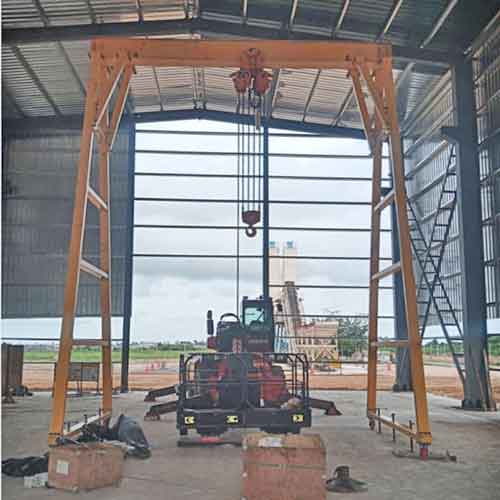
Heavy Components
Industries dealing with heavy and oversized components rely on the strength and precision of 5 Ton A Frame Cranes. The crane's ability to handle substantial loads with ease makes it an ideal choice for lifting and maneuvering heavy components like engine blocks, machinery parts, and structural elements.
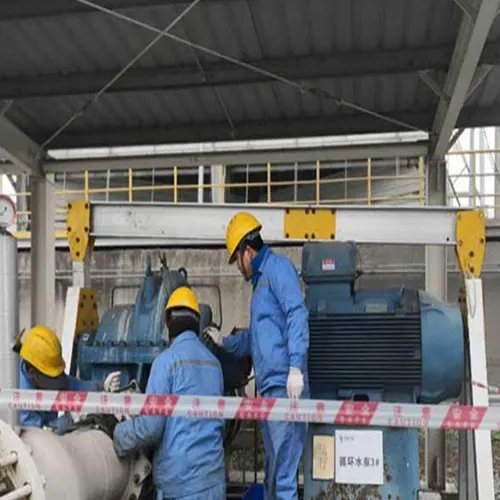
Specialized Loads (e.g., hazardous materials, sensitive equipment)
In environments where the handling of specialized or sensitive loads is required, A Frame Cranes shine. Their precise control systems and adaptable features make them suitable for transporting delicate equipment or hazardous materials with the utmost care and precision, ensuring both safety and operational efficiency.
The versatility of the 5 Ton A Frame Crane extends beyond mere load-bearing capacity; it caters to the diverse needs of industries by accommodating a range of materials, from raw inputs to finished products. This adaptability positions the crane as a versatile solution for businesses seeking a comprehensive material handling solution across various industrial applications.
Comparison with Other 5 Ton Overhead Cranes
Bridge Cranes 5 Ton
Design and Structure
- 5 Ton A Frame Cranes:Feature an A-frame design providing stability and balance. : Well-suited for applications requiring precision in lifting and positioning.
- Bridge Cranes:Employ a horizontal bridge that spans the working are: Suitable for applications demanding long spans and extensive coverage.
Comparison: While A Frame Cranes excel in stability and controlled lifting, Bridge Cranes offer a different structural approach with a horizontal bridge, catering to applications requiring extensive coverage and mobility across larger working areas.
Mobility and Versatility
- 5 Ton A Frame Cranes:Typically offer more compact designs suitable for confined spaces. : Precise movements with adaptable spans and heights.
- Bridge Cranes:Provide extensive lateral mobility along the bridge. : Suited for applications requiring movement over larger distances.
Comparison: A Frame Cranes are advantageous in confined spaces, offering precision, while Bridge Cranes shine in applications where lateral mobility across a broader workspace is crucial.
Application Specifics
- 5 Ton A Frame Cranes:Ideal for general industrial usage, construction sites, and maintenance tasks. : Well-suited for applications requiring stability and controlled movements.
- Bridge Cranes:Commonly used in large manufacturing plants, warehouses, and facilities with expansive working areas. : Cater to applications demanding extensive coverage and lateral mobility.
Comparison: A Frame Cranes find their niche in versatile applications with a focus on stability, while Bridge Cranes are optimal for industries with larger working spaces requiring extensive lateral movement and coverage.
In choosing between a 5 Ton A Frame Crane and a 5 Ton Bridge Crane, the decision hinges on the specific needs of the industry or application. A Frame Cranes excel in precision and stability, making them suitable for various tasks, while Bridge Cranes offer extensive coverage and mobility, making them ideal for larger working environments.
Standard Single Girder Gantry Cranes 5 Ton
Mobility and Portability
- 5 Ton A Frame Cranes:Typically more compact, suitable for confined spaces. : Designed for precise movements with controlled mobility.
- Standard Single Girder Gantry Cranes:Feature a single horizontal girder supported by two legs. : Offer greater portability with the ability to move the entire crane structure.
Comparison: While A Frame Cranes are designed for stability in confined spaces, Standard Single Girder Gantry Cranes provide enhanced portability by allowing the entire structure to move. The choice depends on the level of mobility required for specific applications.
Load Capacity and Span
- 5 Ton A Frame Cranes:Capable of lifting and transporting loads up to 5 tons. : Customizable spans and heights for varying applications.
- Standard Single Girder Gantry Cranes:Similar load capacity but may offer longer spans due to the gantry structure. : Suitable for applications requiring a longer reach or span.
Comparison: Both cranes have a 5-ton load capacity, but the choice may depend on the specific span requirements of the application. A Frame Cranes are adaptable to various spans, while Standard Single Girder Gantry Cranes may offer longer spans due to their structure.
Comparison in Industrial Environments
- 5 Ton A Frame Cranes:Versatile for general industrial usage, construction sites, and maintenance tasks. : Emphasize stability and controlled movements.
- Standard Single Girder Gantry Cranes:Commonly used in shipyards, construction sites, and outdoor applications. : Ideal for environments requiring the crane to move across different locations.
Comparison: A Frame Cranes are versatile and excel in various applications with a focus on stability, while Standard Single Girder Gantry Cranes are better suited for outdoor or dynamic environments where the crane needs to be relocated frequently.
In making a decision between a 5 Ton A Frame Crane and a Standard Single Girder Gantry Crane, considerations should include the required mobility, load capacity, and specific industrial environment needs. A Frame Cranes prioritize stability and controlled movements, while Gantry Cranes offer enhanced portability for applications that demand frequent repositioning.
Jib Cranes 5 Ton
Swinging Arm Design
Jib Cranes: Feature a horizontal swinging arm that extends from a fixed vertical support. Provide a 360-degree range of motion, allowing for precise load positioning.
Comparison: While A Frame Cranes are characterized by an A-frame structure, Jib Cranes distinguish themselves with a swinging arm design that offers greater flexibility in load placement within a confined area.
Precision in Specific Applications
- Jib Cranes: Excel in applications requiring localized precision, such as loading and unloading specific workstations or machines. Ideal for tasks where a concentrated lifting solution is required without the need for extensive lateral mobility.
- Comparison: A Frame Cranes, with their stability and controlled movements, are more versatile across various applications, whereas Jib Cranes are specialized for precise, localized tasks.
Limitations and Advantages
- Limitations of Jib Cranes: Limited lateral mobility compared to A Frame Cranes. May not be suitable for applications requiring extensive coverage.
- Advantages of Jib Cranes: Efficient for tasks in a specific area, maximizing precision. Requires less space than some alternative crane types.
- Comparison: A Frame Cranes provide advantages in terms of stability and adaptability to different applications, but Jib Cranes offer specialized precision in specific work zones with a smaller footprint.
Considerations for Choosing 5 Ton A Frame Cranes Over Alternatives
When considering 5 Ton A Frame Cranes over alternatives like Jib Cranes, Bridge Cranes, or Gantry Cranes, several factors come into play:
- Versatility: A Frame Cranes are more versatile, suitable for various applications due to their stability and adaptability.
- Space Efficiency: In confined spaces, A Frame Cranes might be more suitable than Jib Cranes due to their compact design.
- Lateral Mobility: If the application requires extensive lateral mobility, A Frame Cranes or Gantry Cranes might be more appropriate than Jib Cranes.
- Load Capacity and Precision: A Frame Cranes offer a balance between load capacity and precision, making them suitable for a broader range of applications.
- Cost and Budget Constraints: Consideration of initial investment and long-term operational costs should align with budget constraints.
- Industry-Specific Requirements: Evaluate if the industry's specific material handling requirements are better met by the stability and features of A Frame Cranes.
Choosing between 5 Ton A Frame Cranes and alternatives involves a careful consideration of specific application needs, spatial constraints, and budget considerations. While Jib Cranes may excel in certain precision applications, A Frame Cranes offer versatility and stability across a broader spectrum of industrial tasks.
Selecting the Right 5 Ton A Frame Crane
Assessing Specific Industrial Needs
Selecting the right 5 Ton A Frame Crane begins with a comprehensive assessment of specific industrial needs. Consider the nature of the materials to be handled, the frequency of lifts, and the precision required in positioning loads. Different industries have unique demands, and tailoring the crane to match these requirements ensures optimal performance.
Budgetary Considerations
Budgetary considerations play a crucial role in the selection process. While the 5 Ton A Frame Crane offers a balance between capacity and efficiency, it's essential to align the investment with the expected returns. Evaluate the total cost of ownership, including installation, maintenance, and operational costs, to make an informed decision that aligns with the budget constraints.
Space and Infrastructure Requirements
The physical space and infrastructure available in the industrial setting are pivotal factors in selecting the right crane. A Frame Cranes are known for their adaptability, but ensuring the crane fits seamlessly within the available space is crucial. Consider the required span, lifting height, and any spatial constraints to maximize the crane's efficiency.
Customization Options
The ability to customize the 5 Ton A Frame Crane to specific requirements adds a layer of flexibility to the selection process. Look for manufacturers that offer customization options, allowing you to tailor the crane's features, controls, and dimensions to match the unique demands of your industrial operations. Customization ensures a precise fit for your application.
Choosing the right 5 Ton A Frame Crane involves a thoughtful evaluation of industrial needs, financial considerations, available space, and customization options. A well-informed decision not only enhances material handling efficiency but also contributes to the overall productivity and safety of the industrial environment. By aligning the crane with specific requirements, businesses can maximize their investment and elevate operational performance.
Installation and Maintenance
Proper Installation Procedures
- Site Assessment: Conduct a thorough site assessment to ensure the installation area can support the crane's weight and dimensions. : Verify floor strength, foundation requirements, and overhead clearances.
- Foundation Construction: Follow manufacturer guidelines for constructing a solid foundation to support the A Frame Crane. : Ensure proper alignment and leveling during foundation installation.
- Assembly and Rigging: Assemble crane components according to manufacturer specifications. : Employ experienced riggers to ensure proper attachment and alignment of the hoist, trolley, and structural elements.
- Electrical Connection: Adhere to electrical requirements and safety standards during wiring. : Ensure all connections are secure and in compliance with local regulations.
Routine Maintenance Practices
- Lubrication: Establish a regular lubrication schedule for moving parts to prevent friction and reduce wear. : Use recommended lubricants to maintain optimal performance.
- Visual Inspections: Conduct visual inspections of critical components, such as hooks, ropes, and safety features, to identify signs of wear or damage. : Address any issues promptly to prevent further damage.
- Load Testing: Periodically conduct load testing to verify the crane's capacity and ensure it meets safety standards. : Adjust settings and components as necessary to maintain optimal performance.
- Electrical System Check: Regularly inspect the electrical system for loose connections, damaged wiring, or signs of overheating. : Ensure proper functioning of control mechanisms and emergency stop features.
Addressing Common Issues and Troubleshooting
- Overhead Clearances: If encountering issues with overhead clearances, consider adjusting the crane's height or relocating the installation site.
- Electrical Malfunctions: Inspect and troubleshoot electrical components, such as control panels and wiring, to identify and rectify malfunctions promptly.
- Hoist and Trolley Alignment: Address any misalignment issues with the hoist and trolley system to ensure smooth and precise movements.
- Emergency Stop Failures: Investigate and rectify any failures in the emergency stop system immediately to prevent safety hazards.
Proper installation and routine maintenance are essential for ensuring the longevity and safe operation of a 5 Ton A Frame Crane. Following manufacturer guidelines, conducting regular inspections, and promptly addressing any issues contribute to a reliable and efficient material handling system in industrial settings.
Compliance with Industry Standards and Regulations
OSHA Requirements
- Load Capacity: Adhere to Occupational Safety and Health Administration (OSHA) regulations specifying load capacity limits for cranes. : Ensure that the 5 Ton A Frame Crane's load rating aligns with OSHA guidelines.
- Operator Training: Comply with OSHA requirements for operator training and certification. : Provide comprehensive training programs covering crane operation, safety procedures, and emergency protocols.
- Overhead Clearances: Follow OSHA guidelines on minimum overhead clearances to prevent collisions and ensure safe crane operation.
Local and International Standards
- ANSI/ASME Standards: Align the 5 Ton A Frame Crane design and components with American National Standards Institute (ANSI) and American Society of Mechanical Engineers (ASME) standards.
- CE Marking (European Union): If applicable, ensure compliance with CE marking standards for safety and performance in the European Union.
- National Electrical Code (NEC): Adhere to NEC standards for electrical systems, wiring, and components to ensure safe and code-compliant operation.
Certification and Inspection Processes
- Regular Inspections: Establish a routine inspection schedule for the 5 Ton A Frame Crane in accordance with industry standards. : Conduct visual inspections, load testing, and functional checks to verify compliance.
- Certification: Obtain certification from recognized regulatory bodies or third-party organizations verifying compliance with industry standards. : Display certification prominently to demonstrate adherence to safety and quality standards.
- Documentation: Maintain thorough documentation of inspections, certifications, and any modifications made to the crane. : Keep records accessible for regulatory audits and internal quality control processes.
Compliance with industry standards and regulations is paramount for the safe and legal operation of a 5 Ton A Frame Crane. Organizations must stay informed about OSHA requirements, local and international standards, and certification processes to ensure their equipment meets or exceeds safety benchmarks. Regular inspections, operator training, and meticulous record-keeping contribute to a culture of safety and regulatory compliance within industrial settings.
Case Studies and Success Stories
Examples of 5 Ton A Frame Crane Implementations
- Manufacturing Excellence: In a leading automotive manufacturing facility, 5 Ton A Frame Cranes were deployed for the precise assembly of vehicle components. The A-frame design allowed for efficient maneuvering in confined spaces, contributing to a streamlined production process.
- Construction Site Efficiency: At a large-scale construction site, A Frame Cranes were instrumental in lifting and placing heavy construction materials with precision. The cranes' stability and controlled movements facilitated safe and efficient construction operations.
- Aerospace Innovation: In the aerospace industry, a company integrated 5 Ton A Frame Cranes for the assembly of intricate aircraft components. The cranes' adaptability and customizable features played a crucial role in meeting the industry's stringent precision requirements.
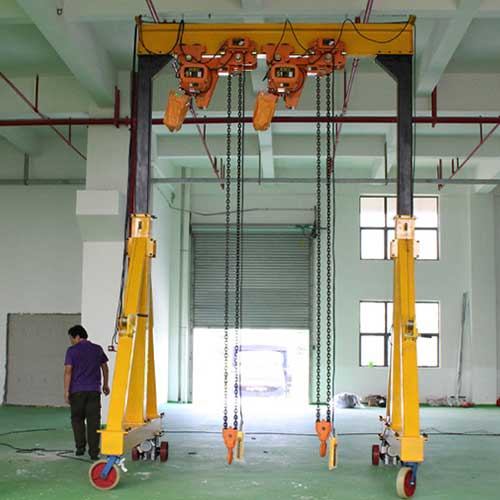
Small a frame gantry cran with adjustable height and low headroom chain hoist for sale
Benefits and Challenges Faced by Industries
Benefits:
- Precision Handling:A Frame Cranes offer precise handling of loads, reducing the risk of damage to delicate components.
- Adaptability:The adaptability of these cranes makes them suitable for various industrial applications with different space constraints.
- Enhanced Safety:The incorporation of safety features such as overload protection and emergency stop mechanisms enhances workplace safety.
- Increased Productivity:Industries report increased productivity due to the efficient material handling capabilities of 5 Ton A Frame Cranes.
Challenges:
- Initial Investment:The initial cost of acquiring and installing 5 Ton A Frame Cranes can be a significant investment for some businesses.
- Specialized Training:Ensuring that operators receive specialized training for A Frame Crane operation can be a challenge, requiring additional resources.
- Space Constraints:In facilities with limited space, finding suitable locations for A Frame Crane installation can pose challenges.
- Maintenance Demands:While routine maintenance is essential, it requires dedicated resources and planning to minimize downtime.
By examining real-world examples and considering the benefits and challenges faced by industries, businesses can gain insights into the practical applications and considerations associated with 5 Ton A Frame Cranes. These case studies illustrate the versatility of these cranes across different sectors and highlight the positive impact they can have on operational efficiency and safety.
Conclusion
In conclusion, the 5 Ton A Frame Crane emerges as a robust and versatile solution for material handling across various industrial applications. Key points highlighted in this comprehensive guide include:
- A Frame Design: The distinctive A-frame design provides stability and balance, making it suitable for precise and controlled lifting operations.
- Applications: From general industrial usage to construction sites and maintenance tasks, A Frame Cranes showcase adaptability and efficiency.
- Technical Specifications: The crane's load capacity, span, height, lifting speed, and safety features contribute to its effectiveness in diverse industrial settings.
- Comparisons: When compared to other overhead cranes like Bridge Cranes and Standard Single Girder Gantry Cranes, A Frame Cranes stand out for their stability, controlled movements, and suitability for confined spaces.
Selection Considerations:
Assessing specific industrial needs, budgetary considerations, space requirements, and customization options are crucial in selecting the right 5 Ton A Frame Crane.
- Installation and Maintenance: Proper installation procedures and routine maintenance practices are essential for the safe and efficient operation of A Frame Cranes.
- Compliance: Adhering to OSHA requirements, local and international standards, and certification processes ensures regulatory compliance and safety.
- Case Studies: Real-world examples illustrate successful implementations of 5 Ton A Frame Cranes in manufacturing, construction, and aerospace industries.
- Benefits and Challenges: The benefits include precision handling, adaptability, enhanced safety, and increased productivity, while challenges include initial investment, specialized training, space constraints, and maintenance demands.
Final Recommendations for You
For potential buyers considering the integration of 5 Ton A Frame Cranes into their operations, the following recommendations are offered:
- Comprehensive Needs Assessment: Conduct a thorough assessment of specific industrial needs to ensure the crane aligns with operational requirements.
- Budget Planning: Consider budgetary constraints and evaluate the total cost of ownership, including installation, maintenance, and operational costs.
- Space Considerations: Evaluate available space and infrastructure to determine the most suitable A Frame Crane configuration.
- Operator Training: Prioritize operator training and certification to ensure safe and efficient crane operation.
- Adherence to Standards: Strictly adhere to OSHA requirements, local and international standards, and certification processes for regulatory compliance and safety.
- Future-Proofing: Consider the potential for future advancements in crane technology and choose a system that allows for easy integration of upgrades.
By following these recommendations, businesses can make informed decisions, maximizing the benefits of 5 Ton A Frame Cranes and ensuring a safe and efficient material handling environment for years to come. Contact us today to check what we can do to save your 5 ton overhead gantry crane cost.
Main Projects
Related Products

Latest project
32/5 Ton Overhead Crane Sale in India: Case Study
Free consultation to Confirm Parameters & Specifications and Get
Latest Crane Price & Crane Rate.
- Types of overhead cranes : _______?
- Optional: Overhead travelling crane, goliath gantry crane,Slewing jib crane, Single girder or double girder crane,small portable crane or kbk crane, etc.
- Capacity of overhead crane: _______?
- Optional: 0.25ton, 0.5 ton, 1 ton, 2 ton, 3ton, 5 ton, 10 ton,15ton, 20ton, 25 ton, 30ton,35ton, up to 550ton, etc.
- Crane span & lifting height : _______?
- Crane travelling length : _____?
- Control of overhead crane:_______?
- Optional: pendant/ remote/cabin control
- Voltage supply of overhead crane:_____?
- Eg,: 380V50/60HZ,3Phase or others,etc.
- Application/usage of crane:_______?
- Eg,: Steel mill, ,injection mold, cement,stone, concrete,granite, general manufacturing, etc.
Just leave a message via the contact form and our hoist and crane engineer will contact you with in 24working hours.
Get In Touch
